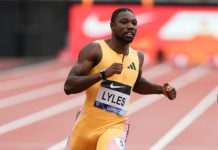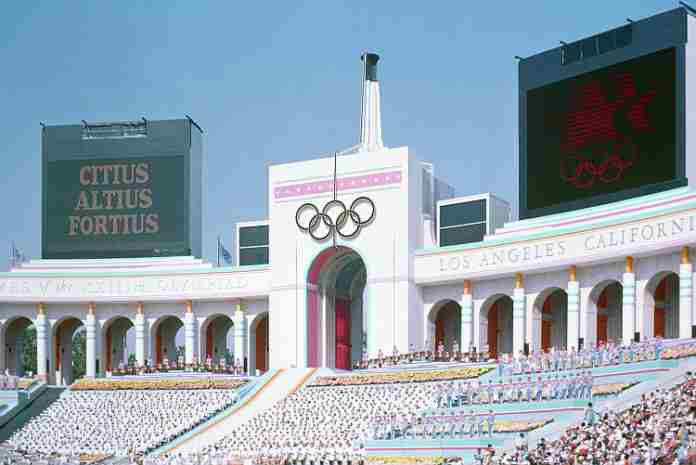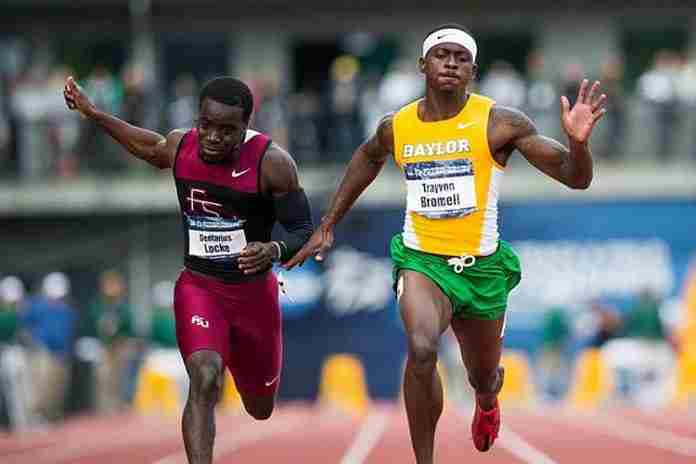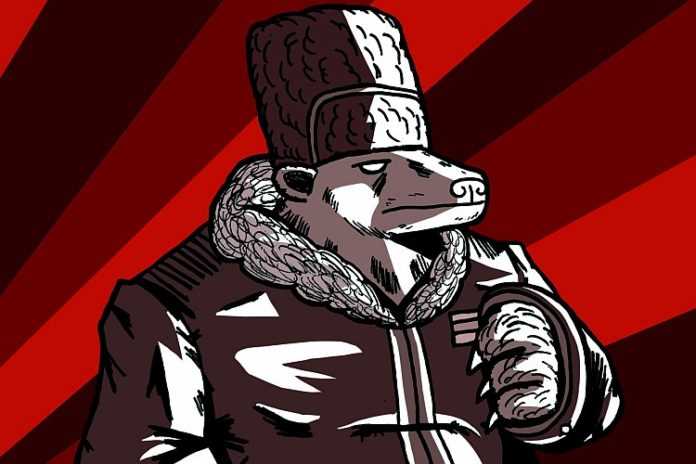(★ Friends: So grateful to have received 43 donations over the past few weeks toward our server and support costs, covering about 89% of the current bill. Almost there, but we could use your help to cover the rest; if you wish, please donate here. Thank you. ★)
For many of us who worked on the Games of the XXIIIrd Olympiad in Los Angeles, 28 July is a special day on the calendar, a day which many critics said would never come: the Opening Ceremony in the Los Angeles Memorial Coliseum.
It launched a revolutionary Games, one which changed the course of the Olympic Movement and was a defining experience for those of us involved in the planning and staging of the Games.
Much has been written about the 1984 Games, including my own work as the Editor-in-Chief of the Official Report of the Games (volume 1 available here and volume 2 here) and the summary work of facts and figures, called Olympic Retrospective: The Games of the Los Angeles (available here). But there are many more people and memories which did not make big headlines, but deserve to be remembered:
● The Los Angeles effort was initially nicknamed the “Spartan Games.” This was not an advertising agency-inspired branding campaign, but in the aftermath of the billion-dollar deficit run up by the Montreal organizers for 1976, the introduction to the thick bid document responding to the questionnaires from the International Olympic Committee and the International Federations began with:
“Arrangements are to be spartan.”
The author was John Argue, the head of the Southern California Committee for the Olympic Games, who had also led the L.A. campaign for the 1980 Games. Argue, the individual most responsible for bringing the Games to Los Angeles, passed up the chance to head the organizing committee, feeling a businessman would be a better fit than a lawyer. He was right.
● Peter Ueberroth was selected as to head the organizing committee on 26 March 1979 and, already a millionaire from his First Travel company – which included the popular Ask Mr. Foster agency – put down a deposit on office space in a Century City office building. When he went to open the door on the first day of occupancy, the key wouldn’t work. The leasing agent couldn’t find any credit information on a “Los Angeles Olympic Organizing Committee” and assumed the company was a fraud.
Needless to say, Ueberroth eventually got the office going. Starting with a shoebox of bills of about $300,000, and with some brilliant guidance from LAOOC Board member David Wolper, the organizing committee had in excess of $2 million in the bank by the 14th of April (how is another story).
● After receiving and dismissing several concepts for the Opening and Closing Ceremonies, Ueberroth turned to Wolper to run the project in 1983. One of the memorable elements of the 1980 Moscow opening was the fabulous card-stunt section that featured the mascot Misha and messages of welcome.
But that was memorably topped during the 1984 Opening by a stupendous stunt that converted the entire Coliseum (sans the press section, of course) into a continuous card section, showing the flags of the nations attending the Games. The credit goes to Mark Flaisher, who had plenty of prior experience as the card-stunt coordinator for the UCLA Rally Committee, which staged many memorable student-section card shows during football games, including night games using flashlights! He’s still at it today, and produced the on-stage show for the 25th anniversary gala held on the Coliseum floor in 2009.
● The organizing committee was guided by a folk-rock group – as we liked to call it – of “Peter, Paul and Harry.” That was Ueberroth, of course; Paul Ziffren, who succeeded Argue was the chair of the Board of Directors and had a major, behind-the-scenes impact on making the Games work within the L.A. political environment, and Harry L. Usher, a well-known entertainment attorney who became the Executive Vice President/General Manager in 1980. Both Ziffren and Usher have passed away, but both contributed mightily to the Games success, and for the staff, Usher’s impact on making the Games work was incalculable (and he was a fun guy … most of the time).
● Because of the financial pressure of having to put on the Games without government guarantees, every department and every requirement was scrutinized thoroughly. The results often changed the way the Games were implemented.
The normal “youth” activity for the organizing committee had been an “International Youth Camp,” with about 1,500 youngsters from around the world coming for the Games period to experience the Olympic spirit and their own mini-village. This offered no benefits for a metropolitan region like Los Angeles and despite IOC objections, the idea was trashed in favor of a four-year program of sports, education and cultural activities.
Some 23 different programs were created under the direction of long-time educator Dan Cruz and paired sports and sponsors for multi-year programs in archery, athletics, basketball, football, handball, judo, sailing, swimming, synchronized swimming, tennis, volleyball, band and drill team and art projects. Combined with a curriculum study for ages 12-17, the program reached 1.25 million participants over four years and was the direct lead-in to the post-Games LA84 Foundation programs that continue to this day.
Same for the cultural program. Often a series of exhibitions and performances during the Games featuring only artists from the host country, the concept was exploded to cover 10 weeks, with most of the action taking place in the eight weeks prior to the Games period.
The “Olympic Arts Festival” was developed by CalArts President Robert Fitzpatrick and staff director Hope Tschopik and was a stunning success all across Los Angeles, thanks to its inclusionary vision and high-profile participants such as the Pina Bausch Wuppertaler Tanztheater from West Germany, Britain’s Royal Opera of Covent Garden and many, many more. Total attendance was in excess of 1.26 million.
● Two not-widely-known but critical senior staff members were Joel Rubenstein and Dick Sargent, both of whom were among the earliest people hired.
Rubenstein and Ueberroth were the early drivers of the LAOOC’s sponsorship sales program that redefined sports marketing worldwide. During Rubenstein’s interview, an impressed Ueberroth asked “how long can you do without being paid?” Joel didn’t have to wait that long for his first check, and after two years in the marketing area, he was asked to lead the thankless Olympic Family Services group, dealing with the IOC and the National Olympic Committees. Rubenstein was nicknamed “Mr. No” for refusing almost any request which might cost more than a nickel, but was lauded during the Games when those things which were promised were actually delivered … and much more. He also was first in line at every hot restaurant in L.A. when entertaining Olympic guests, including the impossible-to-get-into Ma Maison.
Sargent, a friend of Ueberroth since college days at San Jose State, took on the impossible tasks, starting with negotiating the venue leases. His first major deal was with Dr. Jerry Buss, then the owner of the NBA Lakers, NHL Kings and The Forum. Considered the sharpest operator in sports at the time, Buss agreed to very fair terms with the LAOOC for use of The Forum after Sargent proposed to place boxing there – The Forum had an active boxing program – instead of basketball. But Buss wanted basketball and so the deal got done on reasonable terms. That made the rest of the agreements easier.
Among his other tasks? Arranging for the first-ever cross-country Torch Relay, on a scale never before attempted and which raised $10.31 million for charity (about $25.58 million today). And a lot of other, smaller projects that Dick still won’t reveal to this day.
● The worst venue owner to deal with was the Los Angeles Memorial Coliseum Commission. Trying to get an agreement for the Coliseum and the since-demolished Memorial Sports Arena was maddening, so much so that Usher asked me – given my long background in track & field – if the sport could be held in the Rose Bowl!
(There actually had been meets there in June of 1966 and 1967, but on a weird, 385-yard rubberized track. Today, new construction technologies would actually allow Olympic track & field to be held there!)
A deal was finally completed in 1983 and as the construction effort inside the Coliseum was underway in spring 1984, the LAOOC’s brilliant head of architecture & construction, the 6-foot-8 Ed Keen, said the decor could be installed as a semi-permanent feature in the stadium. Nope; the Commission insisted it all had to come down immediately after the Games.
But it was so spectacular (see above) that the Commission asked Keen to leave it up. Of course, since it was not weather-proofed, it decayed rapidly and finally fell apart and was removed in December 1984. Keen is still shaking his head about that one.
● One of the surprises of the Games was the tremendous popularity of soccer (men only), which had the highest total attendance of all sports at 1.42 million (next was track & field at 1.13 million).
There is a direct line between that success and the first FIFA World Cup to be hosted in the U.S. in 1994 and the launch of Major League Soccer in 1996. A key figure in all three was Los Angeles attorney Alan Rothenberg, who served as the LAOOC’s Commission for soccer and went on to head the World Cup ‘94 organizing committee, with another LAOOC alumnus, Scott LeTellier as President.
● If you believed the reporting about the LAOOC in the Los Angeles Times, we were resolutely incensed by criticism of any kind. But that was hardly true, as illustrated by a lengthy, negative critique of the committee’s design program in the January/February 1984 issue of the influential Communication Arts magazine. The author, Larry Klein, impressed Usher so much during the interviews for the story that Klein was himself hired as Director of Design and did a brilliant job integrating the imaginative Festive Federalism concept into every corner of the 1984 Games.
● Even after the Games were over, the LAOOC was being ripped – after announcing an initial surplus estimate of $150 million – for not refunding the Village costs of about $7 million to the National Olympic Committees. Truth be told, the LAOOC was willing to do so, happily, but the United States Olympic Committee – which was to receive 40% of any surplus with another 20% going to the National Governing Bodies – said no.
The 1984 Games was a remarkable success and began a new era of prosperity for the Olympic Movement, which it continues to enjoy today. But it was the people within the LAOOC, from many countries and with many different interests and talents, which made the Games work so well.
We have lost many of our friends, but there are still many left who continue to mark 28 July as a special day. Me too, always.
Rich Perelman
Editor
You can receive our exclusive TSX Report by e-mail by clicking here. You can also refer a friend by clicking here.




























